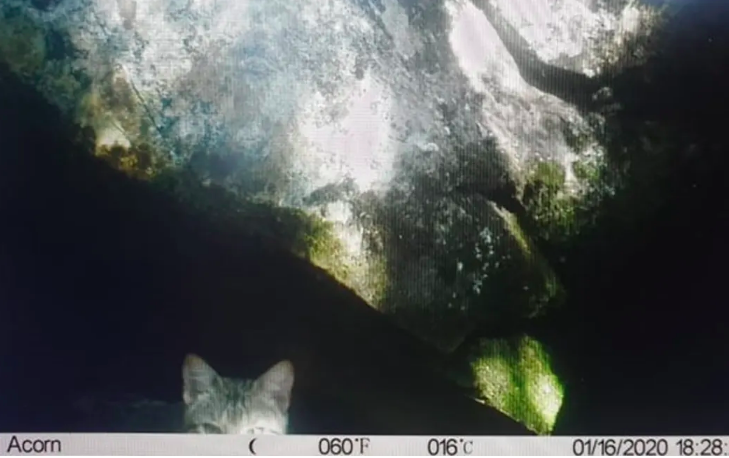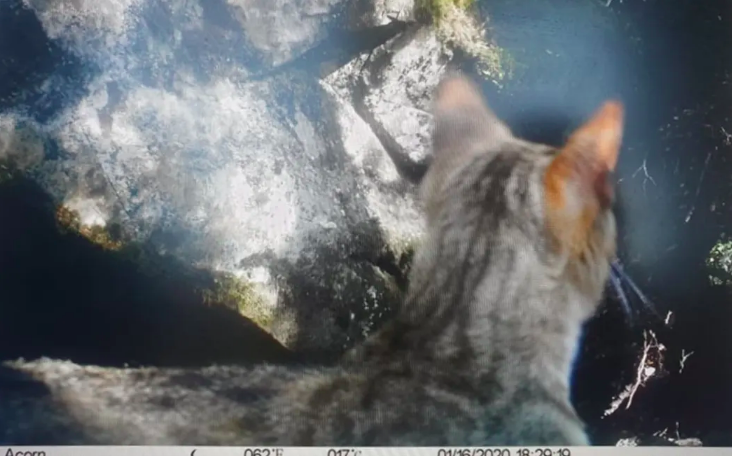100 feral cats caught in Queenstown Lakes' Rees Valley, group steps up trapping efforts
RNZ
05 July 2024, 8:29 PM
 A feral cat on a monitoring camera. PHOTO: Supplied/Southern Lakes Sanctuary Trust
A feral cat on a monitoring camera. PHOTO: Supplied/Southern Lakes Sanctuary TrustFeral cats are causing the deaths of countless native taonga, conservationists say.
The apex predators are different to purring pet moggies or strays. They can weigh up to 7kg and feed on everything.
Multiple groups are working together to try to tackle the problem in the Queenstown Lakes area, but say they are working in often challenging terrain against smart and deadly predators.
Matukituki Charitable Trust is working to clear predators from valleys in Mount Aspiring National Park.
Trustee Gillian Crombie said one feral cat had managed to escape the trust's traps twice.
"There was nothing wrong with the trap, but it was just so big and so strong, it just broke right out of it," Crombie said.
The group's contractors used live traps between May and July.
"Honestly, they're wild. You do not want to touch the trap with bare hands while they're in it. They will do some damage to your hands," she said.
"You need leather gloves and sometimes even that's not enough."

A still photo from a Kea Conservation Trust monitoring camera in the South Island. PHOTO: Supplied/Kea Conservation Trust
The trust is part of the Southern Lakes Sanctuary Trust - a collaboration of local groups trying to protect and restore declining biodiversity.
The sanctuary's planning manager Katrina Black said the groups were working to trap and remove predators in urban and remote terrain.
"We're doing it through farmland, braided rivers, native forest, up in to the national parks, right up into the sub-alpine and alpine environments as well and we're finding feral cats thorough out the whole region," Black said.
"There's nowhere where we do our work where we don't have feral cats."
When group members started trapping at Mount Creighton Station, they spotted about five cats on their cameras.
Across 20 nights, they trapped 37 feral cats using 10 live capture traps along a 1km to 2km stretch of Lake Whakatipu.
"Our minds were blown that that was the number of cats that were in that area," she said.
"That really shows us the scale of the issue that we're dealing with."
Last year, they caught about 100 cats in the Rees Valley.
It was disheartening to find similar numbers of cats through monitoring a year later, but they were determined to keep doing the mahi and clear them out, especially as the valley was a potential site for takahē release, she said.
Group members would be expanding their efforts this year, she said.
Department of Conservation (DOC) Whakatipu operations manager David Butt said feral cats could be found from 2000 metres altitude right down to sea level.
"They're really trap adverse so they won't go into traps. They roam for long distances so they can be hard to find so they're very difficult, time intensive to actually catch," he said.
DOC used a mix of permanent kill traps and live trapping with a variety of baits including rabbit distress calls and crayfish carcasses, he said.
In 2020-21, DOC tagged and monitored a group of kea.

A still photo from a Kea Conservation Trust monitoring camera in the South Island. PHOTO: Supplied/Kea Conservation Trust
Kea Conservation Trust chair Tamsin Orr-Walker said what happened showed how much damage feral cats could do as they targeted adult kea and their young.
"Feral cats reduced adult kea survival in eastern ecosystems - so those are the drier ecosystems east of the divide - to less than 60 percent," she said.
"That's actually a catastrophic event and we know that that hasn't just been an isolated event."
Kea were long-lived and slow to breed so they needed a high survival rate to bolster their population, Orr-Walker said.
She wanted urgent action to tackle the problem including adding feral cats to Predator Free 2050.
"This is just about recognising that we can not have a large, obligate carnivore species that's incredibly efficient at killing our native wildlife in our ecosystems. It's an absolute disaster and we need to be taking it seriously."
Otago Regional Council environmental implementation manager Libby Caldwell said the council supported the sanctuary's work and had given it funding previously.
"Community-led biodiversity and biosecurity work is critical to helping to protect and enhance the environment and we thank the community in their efforts to support achieving joint objectives to see biodiversity and ecosystems thrive."
Feral cats are only included in the Otago Regional Pest Management Plan 2019-2029 for particular site-led programmes.
Those include programmes on the Otago Peninsula, the West Harbour - Mt Cargill area, and Quarantine and Goat Islands.
"Site-led programmes seek to manage additional pests to avoid, mitigate or prevent damage to the indigenous ecosystem values at specific sites," Caldwell said.
The regional council's role in those programmes was advocacy, education and collaboration, she said.







